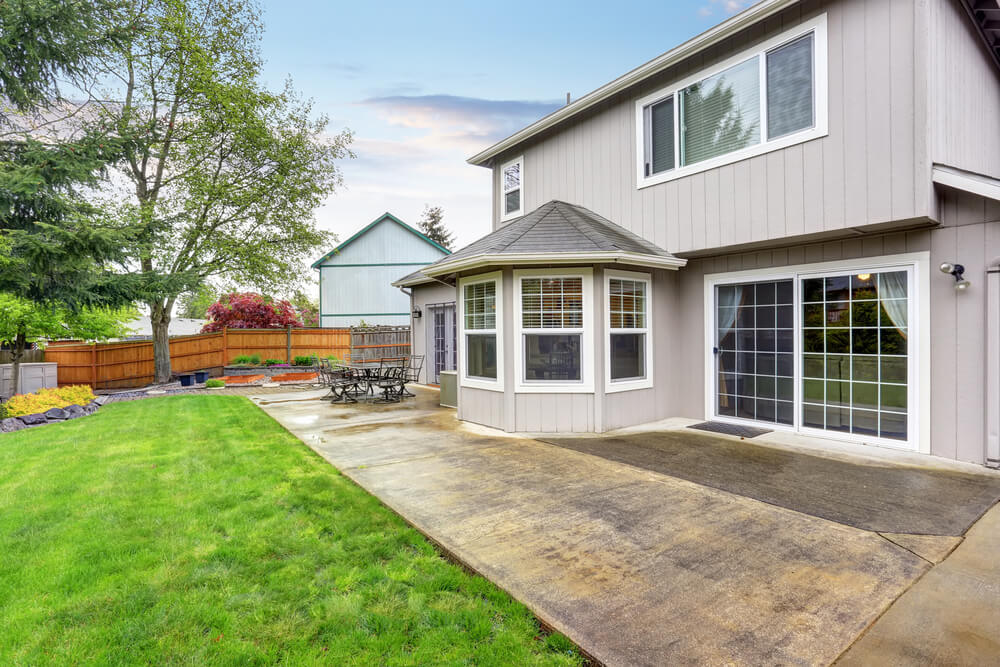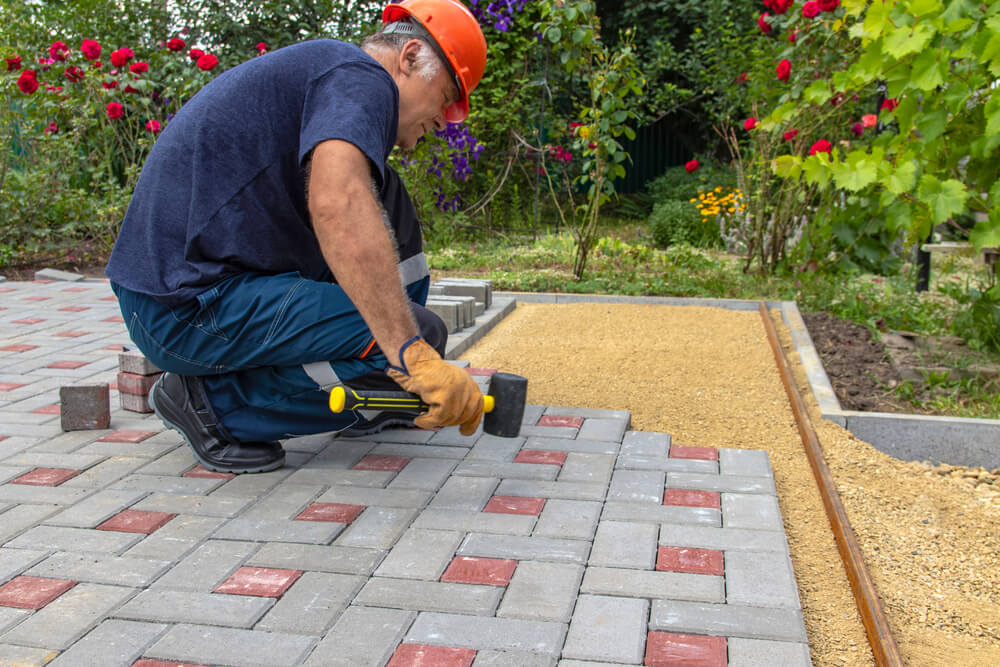Concrete is arguably the most essential material invention in the construction industry. This wonder material made of sand, cement, and gravel sits squarely on almost every structure in the country. Therefore, it is no surprise that many patios are made from concrete.
Despite its durability and versatility, concrete is not indestructible. Because it is made from natural materials, it is porous, and almost everything manages to seep through. Whether from the numerous feet on the pavement or grease and oil from different mechanical parts and grills, concrete can accumulate mud, grime, and other unsightly stains that ruin the overall appearance of the patio.
If you walked past your concrete patio and felt it needed attention, it might be time for spring cleaning. In this article, you can find information on every type of stain and how to restore your patio to its former glory with or without a power washer.
Step-by-Step Guide to Removing Stains From a Concrete Patio
Whenever you choose a concrete patio over asphalt, you have to be dedicated to ensuring the value for your money is maintained. Maintenance practices such as cleaning to remove stains should be done regularly.
Cleaning your patio is a multi-step process often best left to the professionals at Richfield Concrete that involves the following simple steps:
Step 1: Clear the Clutter From the Patio
To begin working on your patio, you must clear the mess first. This allows you to have an unobstructed view of every inch of the surface and assess the areas needing stain removal.
Removing furniture, potted plants, and grills will protect them from the harsh chemicals you will be using to remove stains. After decluttering, you should sweep the patio to remove loose dust and grime in preparation for thorough cleaning.
Step 2: Cover Nearby Greenery and Surfaces for Protection
Because of the harsh nature of the chemicals used in treating the stains on your concrete patio, you should consider covering nearby greenery and any other surface that might come into contact with the chemicals. Bleach can significantly corrode metal surfaces, strip your lawn of a beautiful green color, or sometimes kill the grass.
You can use old newspaper or towels to cover the lawn lining the concrete patio while covering any other wood or metal surface on or around the deck. If this is not possible, you should take extra care to avoid draining the chemicals to the lawn through surface runoff or sprays.
Step 3: Bring in the Chemicals
After ridding your patio of the dust it has accumulated over time, it is finally time to work on the pesky stains that are ruining the aesthetic appeal of the deck. To do this, you first need to treat the stains with chemicals. Treating the stains adequately allows you to reach the grease, oil, or mildew that might have sipped through the porous concrete lattice.
Depending on the nature of the stains, you might be forced to employ a different treatment chemical paired with a corresponding cleaning tool. If you are trying to decide whether you should get out the chlorine-based bleach, the oxygen-based bleach, or even the degreaser, then the next section of this article was made for you.
Removing Mold and Mildew
Removing mold and mildew that might have accumulated from extensive water damage over the years is relatively simple. This is because neither of these stains runs deep into the concrete. If you are lucky, a quick spray of high-pressure water from a garden hose or power washer is enough to do the trick.
However, for those tough stains that just don’t seem to go away, you can mix one part chlorine bleach with two parts water. Dressed in the proper protective equipment , you should scrub your deck with a plastic-bristle brush until the stain barely becomes visible. Finally, you should rinse off the chlorine water and allow the patio to dry.
Removing Greasy Stains
Greasy stains are a pain to get out of, but with the right approach, you don’t have to scrub your fingers to the bone while trying to clean your patio. Grease and oily stains are tough to manage because they sip through the concrete and settle deep within the structure. Consequently, simply cleaning the surface of your deck might not be enough to restore it to its original grandeur.
You should head to the kitchen for some baking soda for the best results. You should then sprinkle this on top of the stain completely covering it, sprinkle some water or vinegar to make a paste, and allow the baking soda to sit for 15-45 minutes. Once the clock runs down, you should gently scrub the stain with the baking soda paste or simply wash it off with some running water, depending on the intensity of the stain.
Occasionally, you may need to use a degreaser, especially when removing the stain is deeper than usual. When removing stains using a degreaser, refer to your manufacturer’s specifications.
Removing Rust Stains
Rust stains usually stain a brick-red color that is conspicuous against the gray backdrop of the concrete. To remove rust stains, you first need to ascertain that the stain on your patio is rust. Depending on your location, the soil may be rich in iron and other ferrous minerals that give the ground a deep red color similar to rust.
Rust stains are usually cleaned using baking soda and water. Dust stains, on the other hand, are usually cleaned with water. Once you are sure the stain you are dealing with is rust, sprinkle some baking soda and water until it forms a paste. You should allow the mixture to sit for half an hour or longer, like removing greasy stains.
Finally, using a brush with rubber or plastic bristles, you should give the concrete a good scrub until the stain disappears.
Step 3: Cleaning the Floors
Once the concrete patio is stain-free, the next step is cleaning the floors. You can use your favorite degreaser, baking soda and vinegar, or muriatic acid to do this. Also, hire a pressure washer to reduce the time and labor to clean the floors.
Caution to Take While Removing Stains From Your Patio
While removing stains from your patio, it is essential to use a measure twice cut once approach to ensure you aren’t left with an unsightly bleached patch of concrete that does not conform to the rest of the patio. Here are a few tips to keep in mind to keep you out of trouble:
Restoring Furniture and Decorative Pieces
You should only restore furniture and other decorative pieces on your patio once the patio is completely dry. This is to prevent them from coming into contact with the chemicals used during cleaning that would otherwise corrode the metal or wood surfaces.
Use a Rubber or Plastic Bristle Brush
Rubber and plastic bristle brushes are preferred when removing stubborn stains from concrete because they do not cause etching on the patio’s surface. Steel brushes often leave characteristic and undesirable scratches that ruin the appeal of the patio. Additionally, rubber and plastic brushes are easy to clean and maintain.
Test Out the Chemicals Before Using Them
When experimenting with certain chemicals or their strengths, you should begin on a small unnoticeable patch of concrete before using it on the rest of the patio. This is to assess whether you are comfortable with the results of removing the stain using your chosen chemical. You must wait until the chemical dries entirely before continuing to the rest of the patio.
Choose Chlorine-Based Bleach Over Oxygen Bleach
Another tip to remember when removing stains from your concrete patio is to prioritize chlorine-based bleach over oxygen bleach. This is because as much as both can remove stains from your patio, oxygen bleaches might strip the patio’s color, giving undesirable results.
It is also crucial to remember not to mix chlorine with other cleaning agents as this is potentially lethal.
Saying Goodbye to Concrete Stains for Good

Stains on your concrete don’t have to attract the wrong kind of attention every time someone walks through your patio. There are several inexpensive ways to keep your patio beautiful without needing power tools or contractors. You should follow the steps highlighted above to bid farewell to stains for good.
Contact Richfield Concrete today to learn more about removing stains from your patio.





